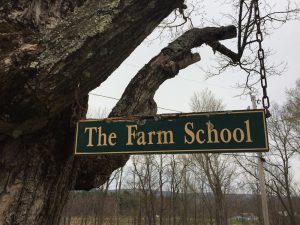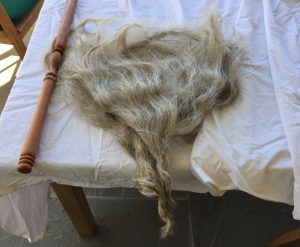One of the fun things I got to do last week was to visit the Farm School in Athol, MA, and to lead a natural dyeing workshop for the participants in their adult farming program. The Farm School combines two of my favorite things: agriculture and education. I had never visited their farm before, so I was thrilled to have the opportunity to be there and to get a better understanding of their different programs. I was greeted by this cheery sign when I first arrived:
Spinning Flax
Last week was April vacation, which meant I had more free time than usual to do fun things. Last Tuesday I was thrilled to spend about four hours with Lisa Bertoldi getting some instruction in spinning flax. You might think, with all the flaxy things I do, that I would already be good at spinning flax. Not yet. It has been a goal for me for many years, but recently it has made it to the top of my “urgent” list. Urgency plus vacation days equals actually devoting time to it! Thanks to Lisa, I am quite a bit better at spinning flax now. (12/30/2023 Edited: Lisa no longer has a website but you can read more about her on the Working Weavers Studio Trail website)
Here is the strick of flax spread out on the table. I am getting the fiber ready to dress the distaff. You can see the distaff on the left:
Fiber Fiber Everywhere
When I’m describing the steps involved in extracting fiber from a fiber-plant such as flax, people often ask, “How on earth did anyone ever figure that out?” I have thought about this question a lot. I have many ideas about it. Some can be backed up with references and citations, and some are just hunches based on my personal experience.
I believe that we humans come from a long line of brilliant thinkers and observers, experimenters and creators. The human use of flax fibers in Europe dates to at least 34,000 years ago. Humans and our human-like relatives and ancestors have been really smart and really creative for tens if not hundreds of thousands of years. Furthermore, primates in general are really smart, so I am happily willing to accept any kind of habitat-modifying, tool-using, culture-teaching behaviors dating back 2 or 3 million years, at least. Which is all very deep. It is admittedly hard to have a clear mental picture of what life might have felt like for a hominid so long ago. Continue reading “Fiber Fiber Everywhere”
Testing Japanese Indigo Seed
In 2014 I was very excited to acquire my first Japanese indigo seedlings at the Massachusetts Sheep and Woolcraft Fair in Cummington, MA. I bought them from Blue By Ewe in Temple, New Hampshire. That year I saved the whole crop for seed. You can read about my harvest in an earlier blog post here. I intended to expand the amount I grew each year and save my own seed annually.
I did manage to grow my own seedlings in 2015, which I documented in a couple posts that you can link to here and here. I even managed to use the plants for dyeing that year. However, I was not on the ball to save seed in an organized way that fall, and I did not grow any Japanese indigo in 2016. Continue reading “Testing Japanese Indigo Seed”


